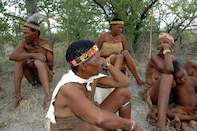Late Stone Age People
So, how do we know anything about Bushman culture at all? Well, luckily, some Bushmen tribes have survived and maintained their traditional culture throughout much of the twentieth century.

For decades, these isolated desert groups have been besieged by researchers and anthropologists intent on documenting every aspect of their lives; trying to study, analyse and extrapolate the life of the Bushmen into a larger understanding of Late Stone Age people around the world.
This movement to lionise the Bushmen has been gaining ground ever since Sir Lourens van der Post wrote his revelatory narratives ‘The Lost World of the Kalahari’ and ‘The Heart of the Hunter’ in the late 1950’s.
But, for all the photographs, words and interviews that have appeared over the years, we have still only gained a vague insight into the complex mind of the Bushmen. One can’t help but feel like we remain on the outside, looking in.
A Single Document
To add to our lack of certainty, very few documents were written about the Bushmen before the twentieth century took hold of the planet and changed things forever.
In fact, we only have a single, reliable ethnographic document, which was transcribed verbatim from authentic Bushmen by sympathetic researchers, that predates the 1900’s.
It is a substantial volume which lays out some basic facts about the Bushman’s world and language, and it forms the cornerstone of our modern understanding of Bushman culture. Ironically, this invaluable text only came to exist because of a war!
In the early 1870’s, the Koranna Wars were raging up in the Northern Karoo. The Koranna were a mixed-blood tribe, made up of Tswana and Griqua, but the local Bushmen were inevitably caught up in the conflict too.
As a result, several /Xam bushmen were taken prisoner by the British and sent to the Breakwater Prison in Cape Town. Here, they met the Prussian linguist Dr. Wilhelm Bleek and his sister-in-law, Lucy Lloyd.
Bleek and Lloyd were fascinated by the archaic culture and strange language exhibited by these prehistoric people and, over the months that followed, they conducted extensive interviews with the prisoners. The data recorded by Bleek and Lloyd is now in the collection of the South African Museum.
A Martyr to Progress
The few remaining Bushmen are still living in the desert, clustered in small communities scattered across South Africa, Namibia, Botswana and Angola.
For years, their needs have been ignored by governments, and their ancient way of life is about to disappear under the pervasive homogenisation of our modern age. In the face of this cultural extinction, I think that we should be proactive about saving this precarious human culture before it disappears in front of our eyes, a reluctant martyr to progress.
 Founded in 1825, the South African Museum is the oldest museum in sub-Saharan Africa. The planetarium is adjacent to the main museum buildin...
Founded in 1825, the South African Museum is the oldest museum in sub-Saharan Africa. The planetarium is adjacent to the main museum buildin... The Main Caves at Giant's Castle is the most commercialised of any rock-art site. A guided tour of the Main Caves Museum, with part authenti...
The Main Caves at Giant's Castle is the most commercialised of any rock-art site. A guided tour of the Main Caves Museum, with part authenti...